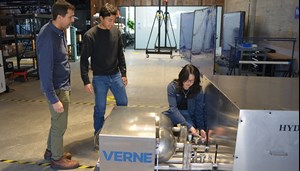News
LLNL and Verne demonstrate highly efficient H2-densification pathway with less required energy
Lawrence Livermore National Laboratory (LLNL) and Verne have demonstrated a novel pathway for creating high-density H2 through a research program funded by Department of Energy’s ARPA-E.
The demonstration validated that it is possible to efficiently reach cryo-compressed H2 conditions with liquid H2-like density directly from a source of gaseous H2 — substantially reducing the energy input required compared to methods that rely on energy-intensive H2 liquefaction.
The energy density of H2 on a mass basis is extremely high. However, at ambient conditions gaseous H2 requires more volume to store an equivalent amount of energy as competing forms of energy storage.

To reduce the storage volume required, densification of H2 is typically accomplished using gas compression or liquefaction. This work demonstrated a pathway that uses both compression and cooling at the same time, each to a lesser degree than when used independently.
So far, the H2 supply chain has been hindered by a trade-off between compressed gaseous H2 — which is cheap to produce, but low in density — and liquid H2 — which is high in density, but expensive to densify (via liquefaction). This trade-off has led to expensive distribution costs that have limited the adoption of H2 solutions.
This demonstration validates that cryo-compressed H2 can break this trade-off by creating high-density H2 without requiring the significant energy inputs required of H2 liquefaction.
Enabling end-use applications of H2. Annual U.S. power consumption is projected to grow by 800 terawatt hours by 2030, with data centers and electric vehicles driving 77% of this new demand, according to the Boston Consulting Group. Customers from a variety of sectors are seeking increased electrical power and are not currently being served by the grid.
H2 can be delivered to these sectors and converted to electricity on-site through a fuel cell, engine or turbine. However, the cost of existing H2 distribution technologies has limited adoption.
“This demonstration confirms that cryo-compressed H2 can break the current trade-off between density and cost,” said Ted McKlveen, co-founder & CEO of Verne. “Providing a low-cost way to reach high densities will bring down the cost of delivering and using H2, opening up a host of applications for H2 across some of the most demanding sectors of the economy from construction to ports to warehouses.”
Collaboration between national lab and industry. Cryo-compressed H2 was originally investigated at LLNL in the late 1990s by Salvador Aceves, who demonstrated its benefits with his team through thermodynamic modeling and built three generations of tanks.
After its founding at Stanford University in 2020 to explore H2 applications in heavy industry, the Verne team began researching cryo-compressed H2 and signed Aceves (then retired from LLNL) as a technical adviser.
Verne began working with LLNL in 2021 through a Strategic Partnership Project to test Verne’s tanks at LLNL’s cryogenic H2 fueling facility. Collaborations progressed through two Cooperative Research and Development Agreements in 2023-24 facilitated by LLNL’s Innovation and Partnerships Office (IPO). This collaboration has provided Verne with access to the unique facilities and expertise required to rapidly test and develop its technology.
“Adoption of H2 is currently inhibited by its high cost,” said Nick Killingsworth, LLNL principal investigator and mechanical engineer. “The sum of this work demonstrates a promising path to reduce the cost and energy associated with its storage and transportation.”
In 2023, LLNL and Verne announced a record for cryo-compressed H2 storage — more than tripling previous records. Verne believes that the densification and H2 storage breakthroughs enable 40% cheaper H2 distribution costs relative to existing technologies; critical cost savings for enabling H2 usage across the economy.
LLNL Business Development Executive Jared Lynch is responsible for the Laboratory’s Energy and Environment intellectual property portfolio as well as its Chemicals & Materials intellectual property portfolios. IPO is the focal point for LLNL’s engagement with industry. It aims to accelerate U.S. competitiveness by identifying new economic opportunities and solutions and transferring those to the private sector through licensing or partnerships.
More efficient densification pathway proven. The novel H2 densification pathway that LLNL and Verne demonstrated produces cryo-compressed H2 without requiring a phase change, leading to 50% energy savings relative to small-scale H2 liquefaction.
During the most recent demonstration, conversion of H2 to 81 Kelvin (-314°F) and 350 bar (one bar is equivalent to atmospheric pressure at sea level) and densities greater than 60 grams per liter were achieved using a catalyst-filled heat exchanger.
In addition to energy savings, this densification pathway is more modular than H2 liquefaction. While H2 liquefaction typically requires construction of large, centralized facilities, cryo-compression can be efficiently built at small scale. This means that the H2 distribution network can be further optimized, locating densification and distribution hubs closer to the points of use.

